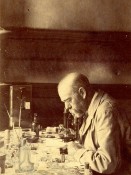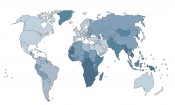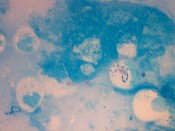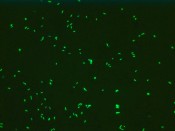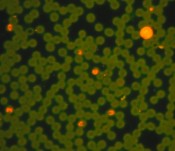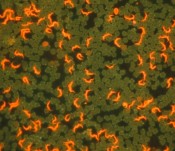|
When tuberculosis faces an even stronger opponent
When tuberculosis faces an even stronger opponentDetecting tuberculosis – contribution to the battle against infectious diseasesTuberculosis (TB) is second only to HIV/ AIDS for the dubious distinction of being the world’s greatest killer. TB is a bacterial disease caused by a single infectious agent, Mycobacterium tuberculosis,which most commonly affects the lungs. It is transmitted from person to person via droplets from the throat and lungs of people who have the active respiratory disease. As late as 2012, some 8.6 million people fell ill with TB and 1.3 million of them died. In that same year, an estimated 530,000 children contracted TB and 74,000 HIVnegative children died of it. Over 95% of deaths occur in low- and middle-income countries, and it is among the top three causes of death in women aged 15 to 44. Yet, on a more positive note, the TB death rate dropped by 45% between 1990 and 2012. Each year the estimated number of people falling ill with tuberculosis is also declining – although very slowly.
Fig.1: Heatmap of the tuberculosis distribution around the world Copyright: Adapted from WHO data
While about a third of the world’s population is infected with tuberculosis bacteria (Fig. 1), only a small proportion of those infected will become sick with the full-blown disease. The symptoms of active TB of the lungs are coughing, sometimes with sputum or blood, chest pains, weakness, weight loss, fever and night sweats. In healthy people, however, infection with the pathogen often causes no symptoms at all since the person’s immune system rallies to fight against the bacteria. Tuberculosis is normally treatable with a six-month course of antibiotics, but diagnosis is crucial. The presence of acid-fastbacilli (AFB) on a sputum smear or other specimen often indicates TB disease. Acidfast microscopy is easy and quick, but it does not automatically confirm a diagnosis of TB because acid-fast-bacilli are not necessarily M. tuberculosis. Therefore, all initial samples should be followed up by a culture which, if positive for M. tuberculosis will verify the diagnosis. Where the fight started At ZEISS, the battle against this killer disease dates back to 1882 and Robert Koch’s groundbreaking discovery of the M. tuberculosis. The celebrated German physician and microbiologist used a ZEISS Microscope VII for his discovery and to this day, the company continues to set the standard with commitment and expertise in the struggle against deadly infectious diseases. TB is curable if properly diagnosed and even over a century later microscopy is still the method of choice. However, budgets and access to microscopes are limited in most of the countries that are most heavily burdened by tuberculosis. In partnership with “Stop TB” ZEISS has joined the collective force that is transforming the fight against TB in more than 100 countries. The “Stop TB Partnership” housed by the World Health Organization (WHO), is determined to forge the path to a world without tuberculosis. ZEISS is also cooperating with the Foundation for Innovative New Diagnostics (FIND), sponsored by the Bill and Melinda Gates Foundation. Through the targeted promotion of diagnostic innovations, the Swiss foundation has set itself the objective of combating the spread of dangerous infectious diseases. Together with FIND, ZEISS has developed Primo Star iLED, the LED-based fluorescence microscope designed specifically for tuberculosis test applications. This microscope brings together all of ZEISS’ experience in light microscopy and has been specially adapted to detect tuberculosis under extreme conditions, even in areas without a power supply. Public health service customers in the most highly burdened countries are eligible to receive this microscope at a special discounted price. No place to hide Primo Star iLED is the flexible solution for tuberculosis test applications, sing LED fluorescence transmitted light brightfield illumination. It enables the precise test of tuberculosis with Ziehl-Neelsen staining in brightfield (Fig.2) or, alternatively, uses fluorescence excitation with Auramine O dye (Fig.3). Fluorescence excitation speeds up detection times by a factor of up to 4 compared to brightfield illumination. Switching between the two modes is simple with Primo Star iLED. Images will show excellent contrast, especially when one is working with specimens stained with auramine-rhodamine. What’s more, Primo Star iLED is equally effective for investigating other infectious diseases such as malaria (Fig.4) and sleeping sickness (Fig.5).
Fig.2: Conventional Ziehl-Neelsen staining of Mycobacterium tuberculosis, brightfield application image Courtesy: Dr. med. Harald Hoffmann, IML Gauting, Germany
Fig.3: Auramine staining of M. tuberculosis, counterstaining Methylene blue fluorescence application image Courtesy: Dr. med. Harald Hoffmann, IML Gauting, Germany
Fig.4: Malaria parasites (small orange structures) inside red blood cells (green) of a baboon experimentally infected with Plasmodium knowlesi and stained with acridine orange. White blood cells also stain orange. Courtesy: Dr. Maina Ngotho, Institute of Primate Research, Nairobi
Fig.5: A thin blood smear stained with acridine orange showing Trypanosomas brucei, the African sleeping sickness pathogen (orange) alongside red blood cells (green), using fluorescence contrast. Courtesy: ZEISS
Precise results in every environment Thanks to the LED illumination, technicians don’t need time to warm up or cool down or to align the illumination when working with fluorescence. The microscope’s long operating life saves costs while it also consumes comparatively little energy. Field operators have the option of working with a mirror and sunlight. Ergonomic eyecups keep ambient light out so they can achieve high-contrast fluorescence images even without a darkroom. In remote areas with fluctuating electricity or none at all, the battery pack is especially handy, and despite the uncompromising quality of its performance the Primo Star iLED can be transported conveniently and safely in its own practical carrying case. Fighting disease on all fronts ZEISS is directly supporting aid and health agencies globally by donating fluorescence microscopes to ensure access to the effective diagnosis of tuberculosis. Among the latest institutions to receive ZEISS microscopes are Malteser International, the worldwide relief agency of the Sovereign Order of Malta, and Morija, a nonprofit organization working in Burkina Faso, Togo, Chad and Cameroon. Other beneficiaries include Projekt Regenzeit e.V., a civil association advocated to help and protect Latin Americas rainforest and its indigenous people, and the German Leprosy and Tuberculosis Relief Association (DAHW), a non-governmental organization that supports medical and social relief programs focusing on the needs of people with leprosy, tuberculosis and other socially excluding diseases and handicaps. Fast and efficient testing // Reflected-light fluorescence // Rapid switching from fluorescence excitation to brightfield illumination // Economical LED concept // Battery pack for operation without a main power supply // Special eyecups to eliminate the need for a dark room during a tuberculosis test // Simple to operate // Durable and robust // Tried-and-tested ZEISS optics made from high-quality glass // High-quality materials // Worldwide support from ZEISS // Transport case, dust and water protected
For more information, please visit: www.zeiss.com/ |
L&M int. 3 / 2014
Free download here: download here The Author:Read more articles online |




